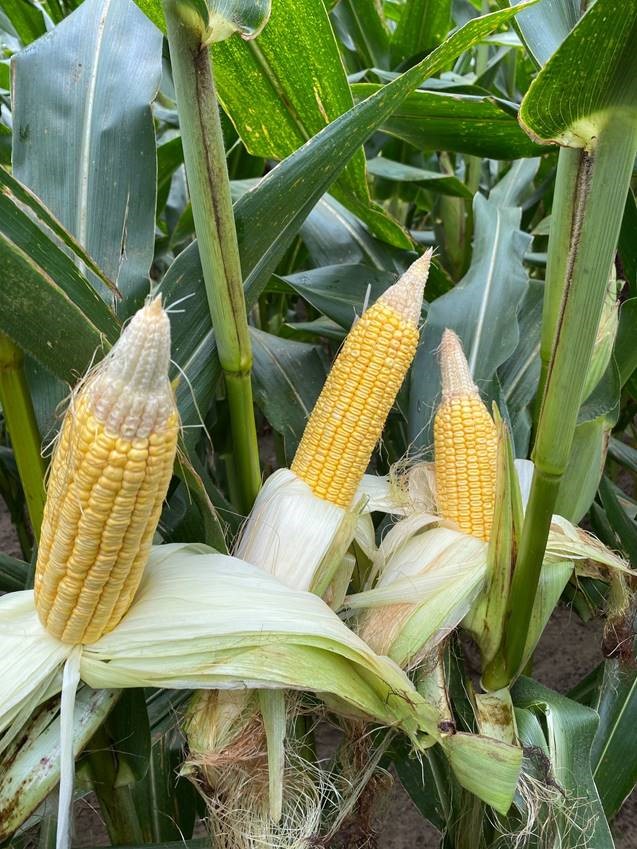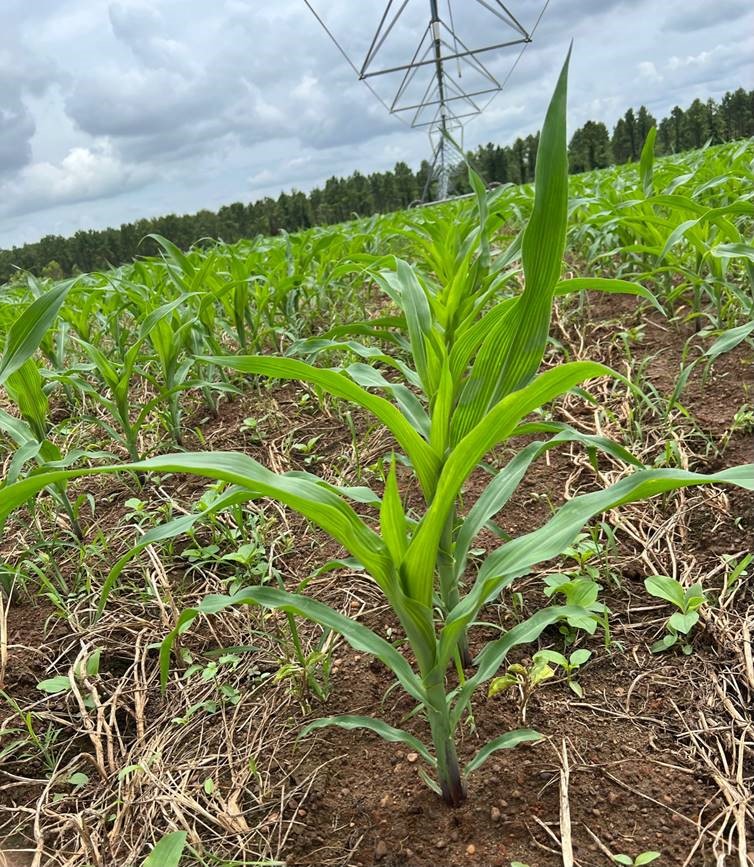Corn
Special Agent Cale Cloud of Grady County just sent me this photo showing denting corn where they had limited irrigation during late pollination(R1) and blister(R2) and perhaps milk(R3) stages. That was when we were having extreme heat and dry weather. On the very tip there was no pollination then as we go down the ear we see the shrunken, aborted kernels. Kernel abortion can only occur through the Blister and Milk stages.

Some of the oldest corn is maturing and reaching ¾ milkline so if you have good moisture at that point the irrigation can be cut off as you are 5-7 days from black layer. Remember its best to harvest corn before it drops below 20% moisture and dry it, so many folks will begin soon.
Some folks plant late corn behind vegetables or even corn. Here’s a photo I took this week of some planted after snap bean harvest and boy is it growing fast. Planted 6-20 and photo taken 7-11 so 21 days old and already at R6. Late corn needs special attention given to water, getting fertilizer sidedress on timely, and watching for worse disease and insect problems.
Here below is an info sheet I wrote up concerning late corn care.

Late Corn after Corn
Rome Ethredge
Late irrigated corn planted after corn in the same field can be done in July in South Georgia. Corn planted very late is risky and will yield lower, of course and have some other problems, but may be profitable.
Usually, we get about a half yield, so 100 bushels per acre or so but sometimes more. We start off with long hot days and end up with short cool days.
Normal corn maturity is in about 130 days but late corn can be ready in 95 days or so. Corn needs about 2700 heat units to make and that’s the difference. I did a study at our Donalsonville, Seminole county weather station for several years and we see from July 20 to Oct 31 you get real close to that heat unit accumulation to get corn mature. A problem can be getting corn to the final phase and ready for harvest as the days are short and can be cool. It will likely need to be dried after harvest. If we have warmer weather in the fall that really helps.
July 20 to Oct 31 Heat Unit Accumulation, Seminole County, Donalsonville, GA
2021 2672 GDD
2020 2737 GDD
2019 2927 GDD
2018 2753 GDD
2017 2645 GDD
2016 2759 GDD
2015 2600 GDD
2014 2597 GDD
Everything moves real fast with a late crop so we need to have fertilizer and herbicide out early and start watering harder, earlier. We want to grow the best plant we can, early for the best yield, and it takes lots of water. Usually we have short, less beefy corn that’s planted very late.
Variety selection is important as a disease and insect resistant hybrid will be needed as insects and diseases are worse that time of year. NCLB and SCLB disease resistance is a must and we’ll still have to spray fungicides several times mainly for Southern Rust. Any Bt hybrid with the Vip3A gene, Syngenta Viptera, Pioneer Leptra, or Dekalb Trecepta will be good. On your seed at least the 500 level seed treatment such as Avicta complete or Poncho Vitivo would be good. Some have used tropical corns but it can be hard to get them dried down in time but would be good for silage.
We would plant less seed, maybe 26,000 seeds per acre. And we may need to plow out volunteer corn if planted right after corn. Directed herbicide may help as well as planting a Liberty resistant hybrid after a nonresistant one but most are resistant to glyphosate and Liberty now and it doesn’t work that well anyway.
In furrow insecticides/nematicides will help. Avoid fields with bad nematode problems. Stinkbugs will likely have to be sprayed at least twice. Sometimes caterpillar sprays are needed as well.
We wouldn’t need as much fertilizer as our yield goal is less, maybe fertilize for 140 Bushels. But we do need to put some at planting and quickly sidedress. Pop up fertilizer will help as we may have a lot of organic matter breaking down around the roots. Maybe a third of the popup with 10-34-0 and 2/3rds Nitrogen since we aren’t facing the early cool season Phosphorus need.
Southern rust will already be here so start fungicides by V8, maybe earlier, scouting is important, ( combo fungicides best). Disease can be a big problem in late corn and will require frequent sprays. Early sprays by a ground rig will work, and then move to the airplane.
Need to watch for Tar spot too but same fungicides should work on it as well.
Corn after corn is somewhat risky business and yields in Georgia aren’t high but has worked for some folks especially in deep south Georgia, especially if you have on-farm drying and good irrigation. Check with who you plan to sell the corn to, to make sure it will have a home once harvested.